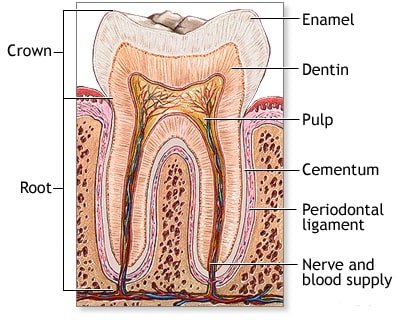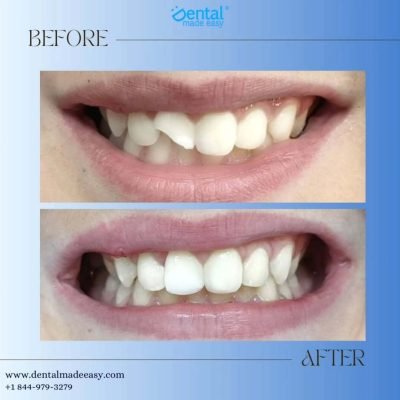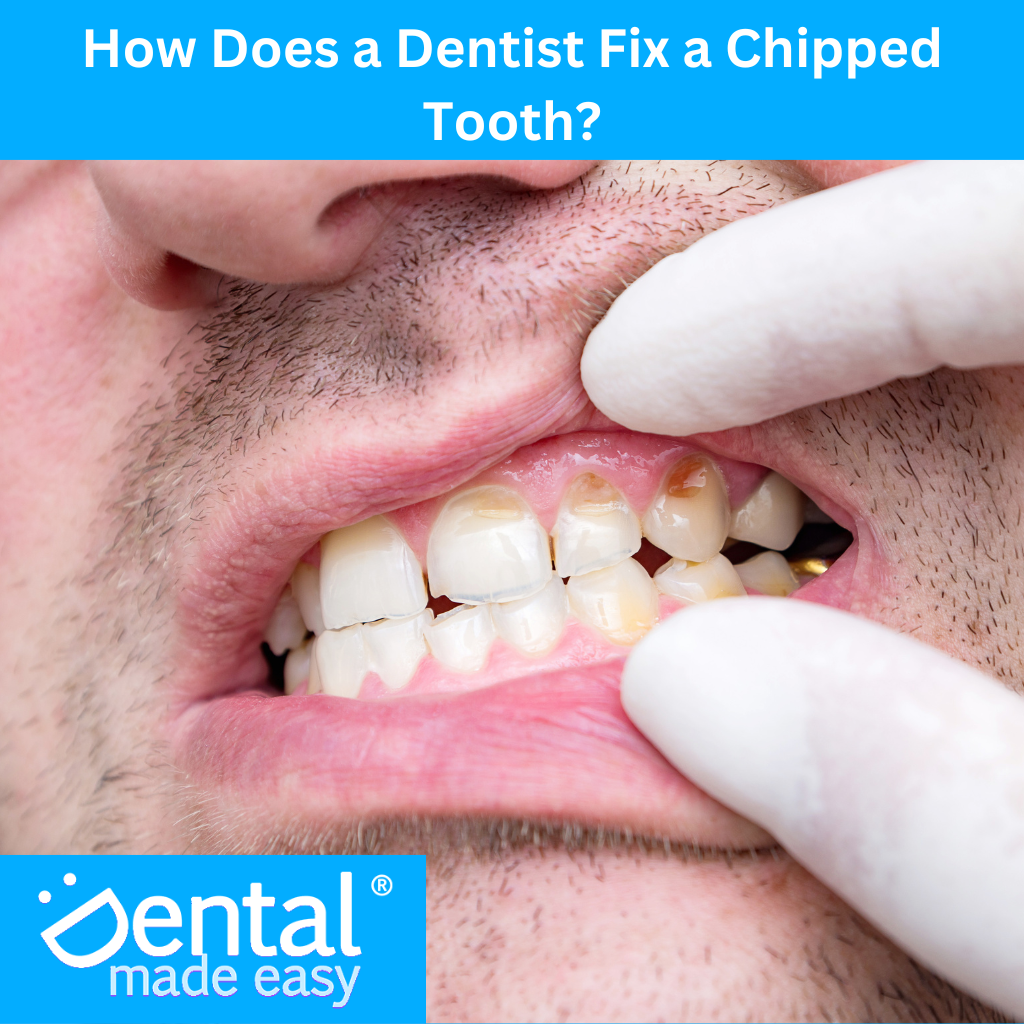A chipped tooth might not seem like a big deal-until it happens to you. Maybe you bit into something unexpectedly hard, or maybe you took a tumble. Either way, seeing (or feeling) a piece of your tooth missing is never a welcome surprise. But here’s the good news: chipped teeth are one of the most common dental issues, and fixing them is usually quick, comfortable, and more affordable than you might think.
In this guide, we’ll explain what causes a chipped tooth, how to know if it’s serious, what your dentist can do to fix it, and how to avoid it in the future.
Table of Contents
What Happens When You Chip a Tooth?
Let’s start with the basics. Your teeth might feel solid as rock, but they’re actually made up of several layers-each playing a different role in how your teeth function and how they respond to damage.
Tooth Anatomy 101
Anatomy of a Tooth (as shown in the image):
- Crown – The visible part of the tooth above the gum line. Covered by enamel.
- Root – The part of the tooth embedded in the jawbone. Anchors the tooth in place.
- Enamel – The hard, outermost layer of the crown. It protects the tooth from wear, decay, and temperature sensitivity. Strongest substance in the human body.
- Dentin – Located beneath the enamel. It’s less hard and more sensitive. It makes up most of the tooth’s structure.
- Pulp – The soft inner part of the tooth that contains nerves and blood vessels. It nourishes the tooth and responds to pain and temperature changes.
- Cementum – A bone-like material covering the tooth root. It helps anchor the tooth by attaching to the periodontal ligament.
- Periodontal Ligament – A group of connective tissue fibers that hold the tooth securely in the socket and absorb pressure during chewing.
- Nerve and Blood Supply – Located within the pulp and root canals, these nourish the tooth and transmit sensory signals.
Tooth layer structure based on MedlinePlus, a publicly available resource developed by the U.S. National Library of Medicine

When enamel chips away, your tooth becomes more vulnerable to pain, bacteria, and further damage. Even a small chip can expose the inner layers, which is why it’s worth having it checked by a dentist. People often wonder about the difference between a chipped tooth and a cracked one. A chipped tooth usually means a small piece has broken off-often visible, sometimes sharp. A crack, however, might run deeper into the tooth and cause pain even if there’s no obvious break. Both require attention, but the fixes can be different.
If you’re in real pain, notice swelling or bleeding, or feel a sharp sting when you breathe in cold air-don’t wait. That could mean the nerve is exposed, and it’s time to see a dentist right away.
What Causes a Chipped Tooth?
There’s no single cause, but a few repeat offenders show up again and again. Some of the most common reasons dentists see chipped teeth include:
Cause | Example |
Hard foods | Ice, nuts, popcorn kernels |
Trauma | Sports injuries, falls, accidents |
Teeth grinding (bruxism) | Often occurs during sleep |
Using teeth as tools | Opening bottles or packages |
Weakened enamel | Decay, erosion, or large fillings |
Large cavities | Untreated decay weakening tooth structure |
Tongue or cheek piercings | Constant contact can wear enamel |
Misaligned bite | Uneven pressure on certain teeth |
Risk Factors for Chipped Teeth
You’re also more likely to chip a tooth if your enamel is already compromised-whether from aging, acid reflux (GERD), or just years of wear and tear.
According to the American Dental Association, 60% of dentists reported seeing more chipped teeth during periods of increased stress-largely due to teeth grinding and jaw clenching.
Additionally, lifestyle habits like chewing on pens or ice, and diets high in acidic or sugary foods, can erode enamel over time and increase your risk of chipping.
- Aging – Enamel naturally wears down over time, making older adults more prone to chips.
- Acid Reflux (GERD) – Stomach acid that reaches the mouth can erode enamel, weakening teeth.
- Poor Oral Hygiene – Insufficient brushing, flossing, and dental visits allow decay to weaken tooth structure.
- High Sugar or Acidic Diet – Frequent consumption of soda, citrus, or sweets can break down enamel.
- Teeth Grinding (Bruxism) – Chronic clenching or grinding-especially at night-puts intense pressure on teeth.
- Previous Dental Work – Large fillings or root canals may leave a tooth structurally weaker.
- Dry Mouth (Xerostomia) – Less saliva means less natural protection against enamel erosion and decay.
- Misaligned Bite or Crooked Teeth – Uneven force when biting increases the risk of localized chipping.
- Nail Biting or Chewing on Hard Objects – Repetitive trauma from habits like biting pens or fingernails can cause small fractures.
- Jaw Trauma History – Previous injuries to the face or jaw may compromise tooth integrity over time.
What Are the Complications of a Cracked Tooth?
A chipped tooth appears minor at first but requires prompt treatment because untreated cases result in serious complications. The protective enamel damage reveals the inner tooth layers to potential harm.
- The following list includes the most frequent complications which occur after a tooth chip.
- The exposed dentin becomes sensitive to heat and cold temperatures and sweet foods.
- The tooth structure damage leads to painful chewing experiences.
- Bacteria penetrate through the chip to reach the pulp which results in tooth infections and potentially abscesses.
- The initial small chip will evolve into either deep cracks or complete tooth breaks throughout time.
- The tooth becomes so damaged that it requires complete removal in severe cases.
The bottom line: don’t wait. Early intervention prevents all these potential complications from occurring. A simple checkup after tooth chipping will protect your entire smile.
Diagnosis and Tests
Wondering how a dentist actually diagnoses a chipped tooth? It’s usually quick and straightforward. Your dentist will start by visually inspecting the tooth, checking how deep the chip goes and whether nerves or sensitive layers are exposed. In most cases, they’ll also take a quick X-ray to ensure there’s no hidden damage beneath the gumline or inside the tooth. This helps determine the best approach to fixing your tooth effectively, comfortably, and safely.
So, How Does a Dentist Fix a Chipped Tooth?
This is probably the first thing on your mind: How do dentists fix a chipped tooth? Or maybe you’re wondering more anxiously, Can a dentist even fix a chipped tooth at all? We hear those questions all the time – and thankfully, the answer is almost always yes.
Better yet, most treatments are faster and more comfortable than you’d expect. Your dentist will assess the damage and choose the best approach based on how big the chip is and where it’s located. Here’s a quick breakdown of what might happen:
Treatment | What It’s For |
Polishing | Best for very small chips-smooths rough edges and blends them naturally with surrounding teeth. |
Ideal for minor to moderate chips-uses tooth-colored resin to restore shape, strength, and appearance. | |
Thin, custom-made porcelain shells placed on front teeth for enhanced aesthetics and minor structural repair. | |
Complete coverage for severely chipped or weakened teeth-protects the tooth and restores full functionality. | |
Fillings | Tooth-colored composite fillings – perfect if the chip has led to decay or cavities. |
Inlays & Onlays | Durable restorations used to repair larger chips or damage, serving as a middle-ground between fillings and crowns. |
Essential treatment if the chip exposes or damages the tooth’s pulp, causing pain or infection. |
Typical Steps to Fix a Chipped Tooth
While your exact treatment may vary depending on the severity and location of the chip, here’s how it usually goes:
- Examination – Your dentist evaluates the chip and may take X-rays.
- Cleaning & Prep – The area is cleaned and isolated to prepare for treatment.
- Treatment – Depending on the case, bonding, a filling, veneer, or crown is applied.
- Shaping & Polishing – Your dentist shapes the restoration to match your natural tooth and polishes it for a smooth finish.
- Aftercare Guidance – You’ll get instructions on how to care for the repaired tooth and when to follow up if needed.
Want to see what chipped tooth repair looks like in real life?
Watch this quick treatment demo on YouTube to see how dentists fix chips efficiently and comfortably.
Outlook / Prognosis
If you’ve chipped a tooth, here’s the reassuring news: with prompt care, nearly all chipped teeth can be successfully repaired. Minor chips usually require simple, quick treatments like bonding or polishing. Moderate to severe cases might need fillings, veneers, or crowns, but these also have excellent long-term success rates. Bottom line-most patients leave the dentist’s office with a fully restored, pain-free smile that looks and functions naturally, especially when treatment is timely.Living with a Chipped Tooth (Short-Term Care)
We know that waiting to see a dentist when you have chipped a tooth can be uncomfortable (and a bit scary). But don’t worry. There are a few things you can do right now to protect your teeth and minimize damage:- Avoid chewing on that side
- Eat soft foods
- Rinse with warm water to keep the area clean
- Cover any sharp edges with dental wax or sugarless gum
- If you have pain, over-the-counter pain medication can help. You could also use ice packs to ease the pain.
- If you saved the broken piece, place it in milk and bring it to your appointment.
When Is a Chipped Tooth Considered a Dental Emergency?
Not every chipped tooth is urgent-but some absolutely are. If you’re experiencing severe pain, notice bleeding, or suspect that the chip may have exposed the nerve inside your teeth, that’s a dental emergency. The same goes for any visible swelling, pus, or signs of infection. Call your dentist immediately. Acting fast can help you save the tooth and avoid complications like an abscess or permanent damage.What to Do Until You Get to the Dentist:
- Rinse your mouth gently with warm water to keep the area clean.
- Apply gauze to stop bleeding, if any.
- Use dental wax or sugar-free gum to cover sharp edges and protect your tongue.
- Take over-the-counter pain relief if needed.
- Avoid chewing on the injured side of your mouth.
- Try to recover the piece, rinse it with water (don’t scrub),
- Place it in cold milk or saline, and
- Bring it with you to the dental office-there’s a chance it can be reattached.
When to Go to the Dentist for a Chipped Tooth?
If you’re debating whether to go to the dentist after chiseling a tooth, here is your sign – it’s better to go to the dentist sooner than later. Even a small chip exposes the tooth to bacteria; your tooth could decay, become sensitive, or chip again because of the bacteria’s accessibility. Treating a small chip sooner typically means you will have a simpler treatment, a shorter visit, and less expense. When you eventually visit the dentist, you shouldn’t be shy with your questions. Here are some questions people frequently have:- Will it need bonding, a crown, or other repair?
- How long before a crown or other repair will I need to have it replaced?
- Was it just cosmetic, or is the tooth compromised?
- What does my insurance cover in this case?
How to Avoid Chipping a Tooth Again
It’s easy to forget that your teeth are not indestructible until you chip one. Most chipping is avoidable, with just a few added precautions.Do not chew on things like ice or pen caps, and try not to use your teeth to open packages; also avoid biting into things that are very hard. If you participate in contact sports, protect your teeth with a mouthguard. If you grind your teeth at night, see your dentist about a custom nightguard to preserve enamel. Also, consider your diet. You should limit your consumption of acidic or sugary foods to help prevent the gradual wearing down of tooth structure. Certainly brushing, flossing and regular visits to the dentist will help keep your teeth healthy. Some smart habits now can help in avoiding bigger issues down the road, and will help to keep your smile complete and intact for the future.How to Avoid Chipping a Tooth Again
It’s easy to forget that your teeth are not indestructible until you chip one. Most chipping is avoidable, with just a few added precautions.Do not chew on things like ice or pen caps, and try not to use your teeth to open packages; also avoid biting into things that are very hard. If you participate in contact sports, protect your teeth with a mouthguard.
If you grind your teeth at night, see your dentist about a custom nightguard to preserve enamel. Also, consider your diet. You should limit your consumption of acidic or sugary foods to help prevent the gradual wearing down of tooth structure. Certainly brushing, flossing and regular visits to the dentist will help keep your teeth healthy. Some smart habits now can help in avoiding bigger issues down the road, and will help to keep your smile complete and intact for the future.

Absolutely, Your Smile Can Be Saved
Chipped teeth are one of the most common concerns we see at Dental Made Easy-and one of the simplest concerns for our dentists to address! Whether you need bonding, a filling, or a full crown, our dentists will ensure that your repair looks and feels just like a natural tooth. We use highly sophisticated and advanced materials and shade-matching tools so your repair blends in. Most treatments can be performed in one visit you’ll be walking out smiling again-same smile, now confident and pain-free.
Need to Fix a Chipped Tooth? We’re Here to Help
We get it-stuff happens. But chipped teeth don’t have to stay chipped. At Dental Made Easy, we make the process simple and stress-free. Book your visit at one of our New York locations today:
Forest Hills
📍 116-20 Queens Blvd, Forest Hills, NY 11375
📞 (718) 507-7781
Garden City Park
📍 2374 Jericho Turnpike, Garden City, NY 11040
📞 (516) 588-6622
Prospect Park South
📍 2233 Caton Ave, Brooklyn, NY 11226
📞 (718) 504-5959
Astoria
📍 28-18 Steinway Street, Astoria NY 11103
📞 (718) 626-9800
FAQs About Chipped Teeth
We get a lot of questions about chipped teeth, especially from patients seeing one for the first time. Here are some of the most common ones, along with clear, straightforward answers:


